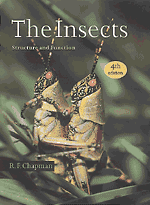Book contents
- Frontmatter
- Contents
- Preface
- Acknowledgments
- PART I The Head, Ingestion, Utilization and Distribution of Food
- 1 Head
- 2 Mouthparts and feeding
- 3 Alimentary canal, digestion and absorption
- 4 Nutrition
- 5 Circulatory system, blood and immune systems
- 6 Fat body
- PART II The Thorax and Locomotion
- PART III The Abdomen, Reproduction and Development
- PART IV The Integument, Gas Exchange and Homeostasis
- PART V Communication
- Taxonomic index
- Subject index
5 - Circulatory system, blood and immune systems
Published online by Cambridge University Press: 05 June 2012
- Frontmatter
- Contents
- Preface
- Acknowledgments
- PART I The Head, Ingestion, Utilization and Distribution of Food
- 1 Head
- 2 Mouthparts and feeding
- 3 Alimentary canal, digestion and absorption
- 4 Nutrition
- 5 Circulatory system, blood and immune systems
- 6 Fat body
- PART II The Thorax and Locomotion
- PART III The Abdomen, Reproduction and Development
- PART IV The Integument, Gas Exchange and Homeostasis
- PART V Communication
- Taxonomic index
- Subject index
Summary
CIRCULATORY SYSTEM
Structure
Insects have an open blood system with the blood occupying the general body cavity, which is known as a hemocoel. Blood is circulated mainly by the activity of a contractile dorsal longitudinal vessel which opens into the hemocoel. The hemocoel is often divided into three major sinuses; a dorsal pericardial sinus, a perivisceral sinus, and a ventral perineural sinus (Fig. 5.1). The pericardial and perineural sinuses are separated from the visceral sinus by the dorsal and ventral diaphragms, respectively. In most insects, the visceral sinus occupies most of the body cavity, but in ichneumonids the perineural sinus is enlarged.
Reviews: Hoffman, 1976; Jones, 1977; Miller, 1985a
Dorsal vessel
The dorsal vessel runs along the dorsal midline, just below the terga, for almost the whole length of the body although in the thorax of adult Lepidoptera and at least some Hymenoptera, it loops down between the longitudinal flight muscles (see Fig. 19.3). It may be bound to the dorsal body wall or suspended from it by elastic filaments. Anteriorly it leaves the dorsal wall and is more closely associated with the alimentary canal, passing under the brain just above the esophagus. It is open anteriorly, ending abruptly in most insects, but as an open gutter in orthopteroids. Posteriorly, it is closed, except in larval mayflies (Ephemeroptera) where three vessels diverge to the caudal filaments from the end of the heart.
- Type
- Chapter
- Information
- The InsectsStructure and Function, pp. 94 - 131Publisher: Cambridge University PressPrint publication year: 1998
- 4
- Cited by



